University Report: Robotic Process Automation Analysis
VerifiedAdded on 2021/04/16
|8
|1537
|116
Report
AI Summary
This report delves into Robotic Process Automation (RPA), exploring its definition as an autonomous automation system using rule-based inputs to simulate human actions. It discusses RPA's applications in various fields, including process automation, and its evolution to include machine learning. The report focuses on the 'Swivel Chair Process,' where RPA automates repetitive tasks like payment transactions and record-keeping. It examines the implementation of RPA using an agile approach, highlighting benefits such as continuous evaluation, risk management, and flexibility. The report also outlines success factors for RPA implementation, including governance, environmental change management, and process identification. Furthermore, it details the advantages of RPA, such as cost-effectiveness, risk reduction, and quality improvement, while also addressing the future integration of RPA with artificial intelligence. In conclusion, the report underscores the value of RPA as an integral digital transformation tool, emphasizing the importance of proper process selection, implementation, and maintenance.
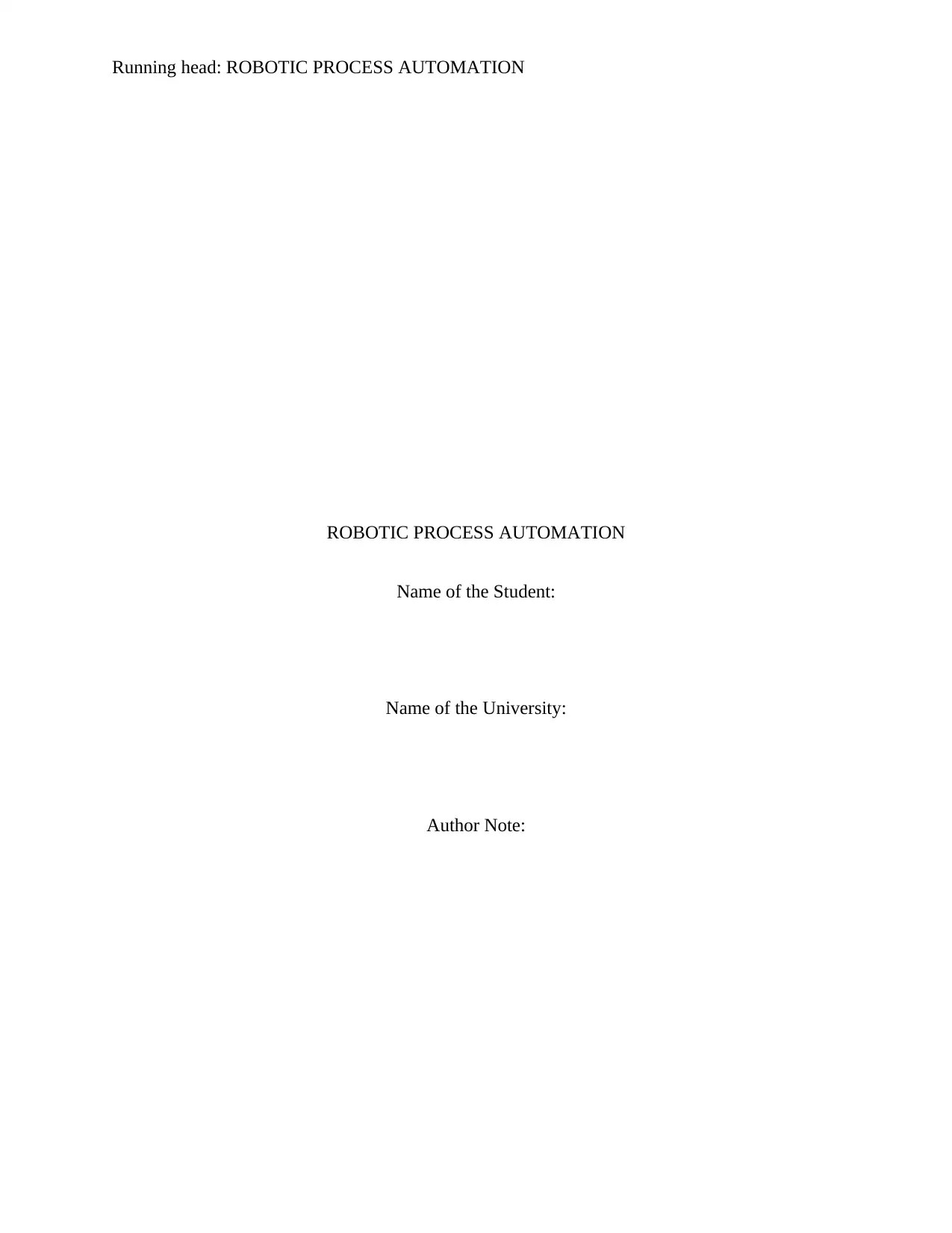
Running head: ROBOTIC PROCESS AUTOMATION
ROBOTIC PROCESS AUTOMATION
Name of the Student:
Name of the University:
Author Note:
ROBOTIC PROCESS AUTOMATION
Name of the Student:
Name of the University:
Author Note:
Paraphrase This Document
Need a fresh take? Get an instant paraphrase of this document with our AI Paraphraser
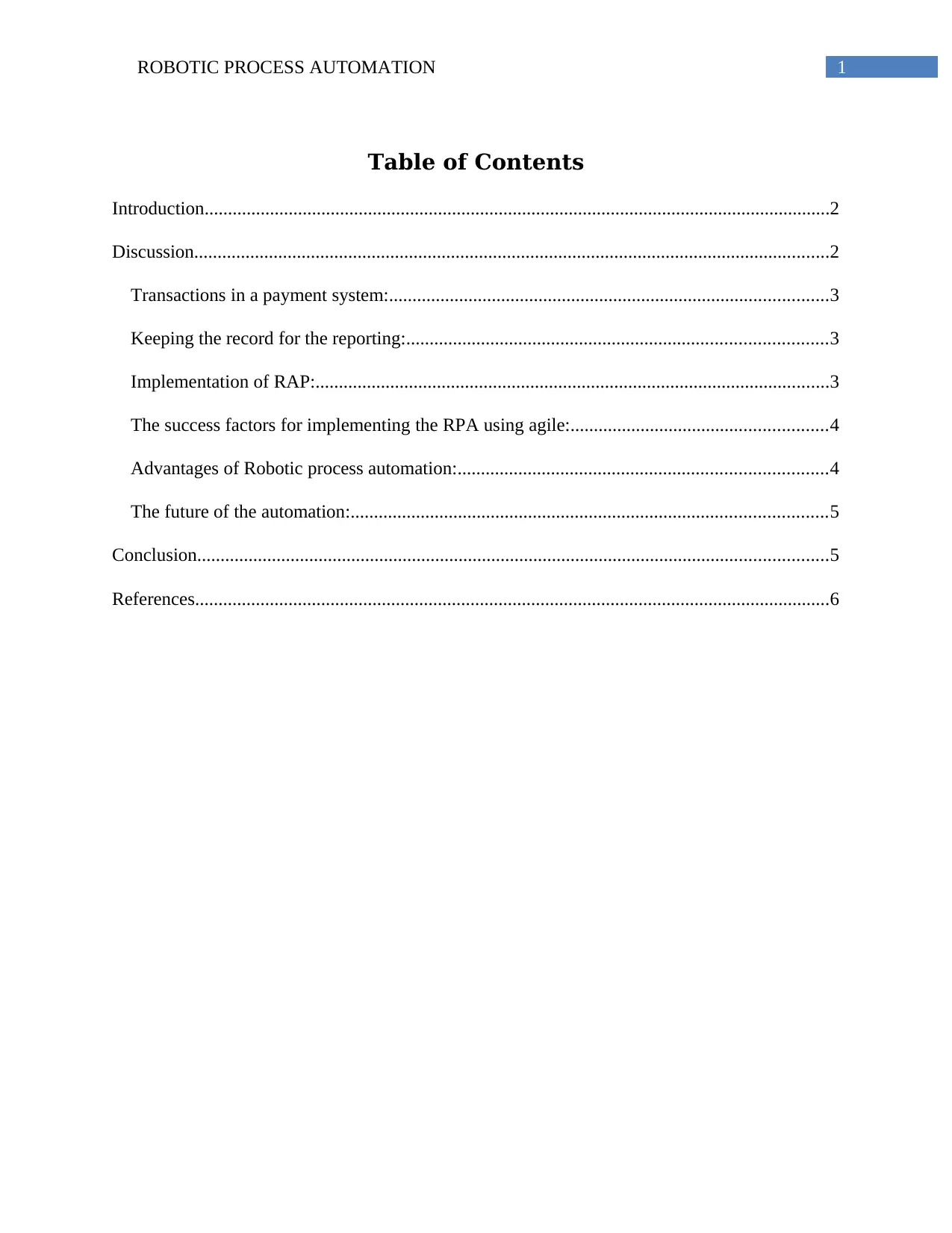
1ROBOTIC PROCESS AUTOMATION
Table of Contents
Introduction......................................................................................................................................2
Discussion........................................................................................................................................2
Transactions in a payment system:..............................................................................................3
Keeping the record for the reporting:..........................................................................................3
Implementation of RAP:..............................................................................................................3
The success factors for implementing the RPA using agile:.......................................................4
Advantages of Robotic process automation:...............................................................................4
The future of the automation:......................................................................................................5
Conclusion.......................................................................................................................................5
References........................................................................................................................................6
Table of Contents
Introduction......................................................................................................................................2
Discussion........................................................................................................................................2
Transactions in a payment system:..............................................................................................3
Keeping the record for the reporting:..........................................................................................3
Implementation of RAP:..............................................................................................................3
The success factors for implementing the RPA using agile:.......................................................4
Advantages of Robotic process automation:...............................................................................4
The future of the automation:......................................................................................................5
Conclusion.......................................................................................................................................5
References........................................................................................................................................6
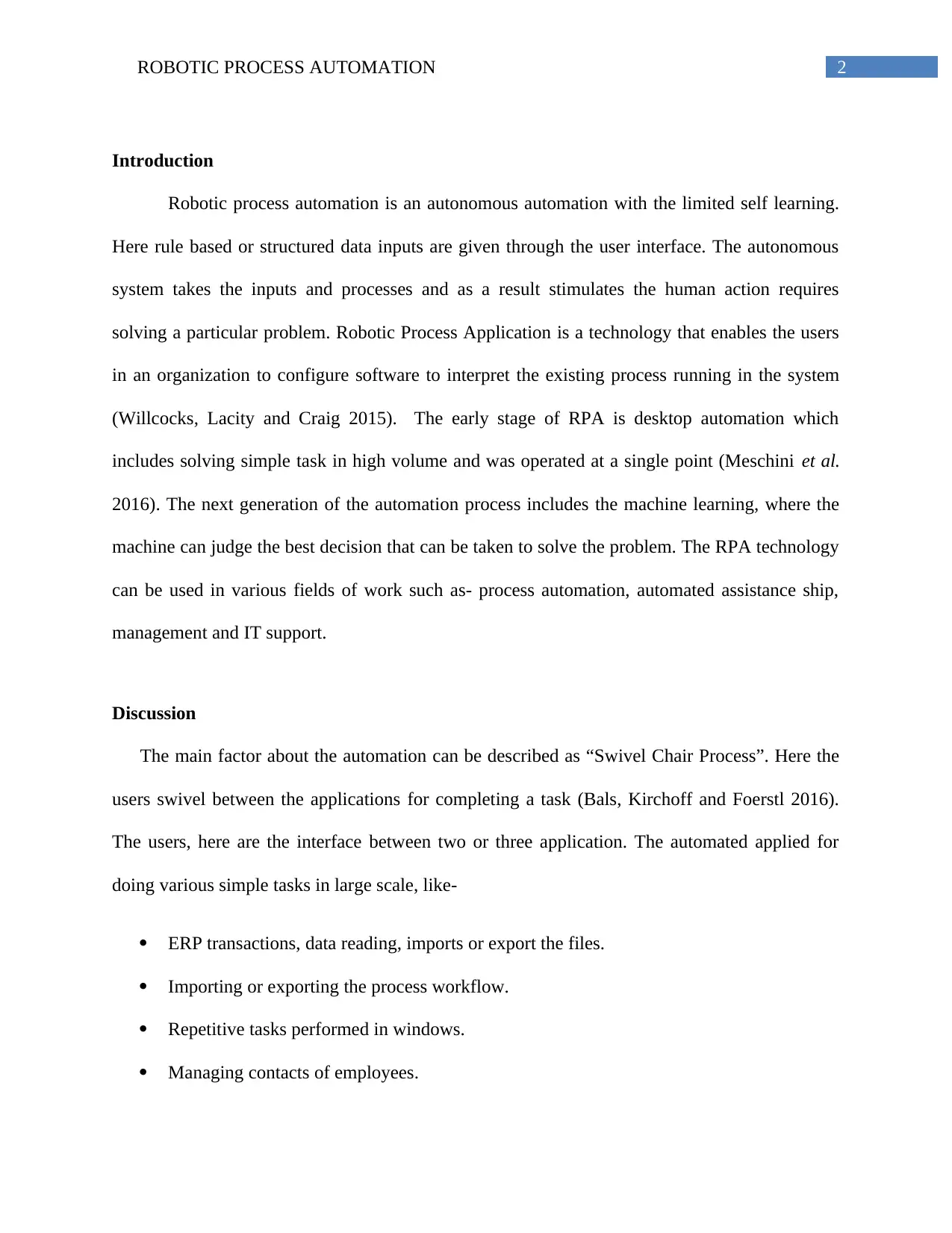
2ROBOTIC PROCESS AUTOMATION
Introduction
Robotic process automation is an autonomous automation with the limited self learning.
Here rule based or structured data inputs are given through the user interface. The autonomous
system takes the inputs and processes and as a result stimulates the human action requires
solving a particular problem. Robotic Process Application is a technology that enables the users
in an organization to configure software to interpret the existing process running in the system
(Willcocks, Lacity and Craig 2015). The early stage of RPA is desktop automation which
includes solving simple task in high volume and was operated at a single point (Meschini et al.
2016). The next generation of the automation process includes the machine learning, where the
machine can judge the best decision that can be taken to solve the problem. The RPA technology
can be used in various fields of work such as- process automation, automated assistance ship,
management and IT support.
Discussion
The main factor about the automation can be described as “Swivel Chair Process”. Here the
users swivel between the applications for completing a task (Bals, Kirchoff and Foerstl 2016).
The users, here are the interface between two or three application. The automated applied for
doing various simple tasks in large scale, like-
ERP transactions, data reading, imports or export the files.
Importing or exporting the process workflow.
Repetitive tasks performed in windows.
Managing contacts of employees.
Introduction
Robotic process automation is an autonomous automation with the limited self learning.
Here rule based or structured data inputs are given through the user interface. The autonomous
system takes the inputs and processes and as a result stimulates the human action requires
solving a particular problem. Robotic Process Application is a technology that enables the users
in an organization to configure software to interpret the existing process running in the system
(Willcocks, Lacity and Craig 2015). The early stage of RPA is desktop automation which
includes solving simple task in high volume and was operated at a single point (Meschini et al.
2016). The next generation of the automation process includes the machine learning, where the
machine can judge the best decision that can be taken to solve the problem. The RPA technology
can be used in various fields of work such as- process automation, automated assistance ship,
management and IT support.
Discussion
The main factor about the automation can be described as “Swivel Chair Process”. Here the
users swivel between the applications for completing a task (Bals, Kirchoff and Foerstl 2016).
The users, here are the interface between two or three application. The automated applied for
doing various simple tasks in large scale, like-
ERP transactions, data reading, imports or export the files.
Importing or exporting the process workflow.
Repetitive tasks performed in windows.
Managing contacts of employees.
⊘ This is a preview!⊘
Do you want full access?
Subscribe today to unlock all pages.

Trusted by 1+ million students worldwide
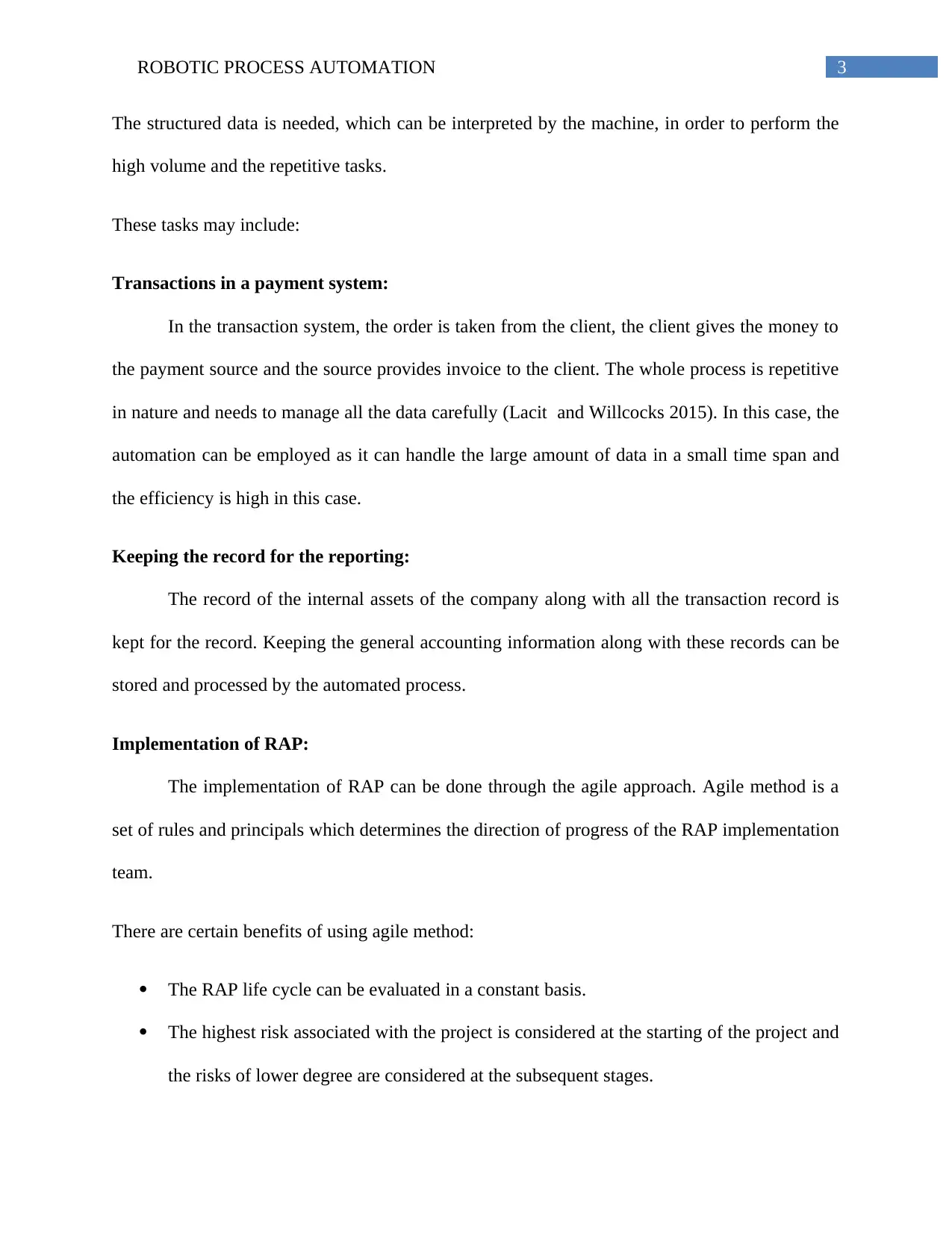
3ROBOTIC PROCESS AUTOMATION
The structured data is needed, which can be interpreted by the machine, in order to perform the
high volume and the repetitive tasks.
These tasks may include:
Transactions in a payment system:
In the transaction system, the order is taken from the client, the client gives the money to
the payment source and the source provides invoice to the client. The whole process is repetitive
in nature and needs to manage all the data carefully (Lacit and Willcocks 2015). In this case, the
automation can be employed as it can handle the large amount of data in a small time span and
the efficiency is high in this case.
Keeping the record for the reporting:
The record of the internal assets of the company along with all the transaction record is
kept for the record. Keeping the general accounting information along with these records can be
stored and processed by the automated process.
Implementation of RAP:
The implementation of RAP can be done through the agile approach. Agile method is a
set of rules and principals which determines the direction of progress of the RAP implementation
team.
There are certain benefits of using agile method:
The RAP life cycle can be evaluated in a constant basis.
The highest risk associated with the project is considered at the starting of the project and
the risks of lower degree are considered at the subsequent stages.
The structured data is needed, which can be interpreted by the machine, in order to perform the
high volume and the repetitive tasks.
These tasks may include:
Transactions in a payment system:
In the transaction system, the order is taken from the client, the client gives the money to
the payment source and the source provides invoice to the client. The whole process is repetitive
in nature and needs to manage all the data carefully (Lacit and Willcocks 2015). In this case, the
automation can be employed as it can handle the large amount of data in a small time span and
the efficiency is high in this case.
Keeping the record for the reporting:
The record of the internal assets of the company along with all the transaction record is
kept for the record. Keeping the general accounting information along with these records can be
stored and processed by the automated process.
Implementation of RAP:
The implementation of RAP can be done through the agile approach. Agile method is a
set of rules and principals which determines the direction of progress of the RAP implementation
team.
There are certain benefits of using agile method:
The RAP life cycle can be evaluated in a constant basis.
The highest risk associated with the project is considered at the starting of the project and
the risks of lower degree are considered at the subsequent stages.
Paraphrase This Document
Need a fresh take? Get an instant paraphrase of this document with our AI Paraphraser

4ROBOTIC PROCESS AUTOMATION
The agile method is flexible enough to adopt the change the project environment.
In the agile approach the initial phase is of gathering the user’s story. The user story includes
knowing of the requirements of the users clearly. The team members, then decides to deliver the
project fulfilling the requirements as much as possible at the end of the sprint (Ramamurthy et al.
2017). The decisions can be taken after the sprint planning meeting. The division of the task is
done after this phase, which is known as the sprint blockage (Kirchmer 2017). The sprint can be
of two types, for the argent requirement clarification, the sprint can be of 24 hours where the
team members can do a meeting with the clients for further clarification. The sprint process for
1-4 weeks and that time frame can be used for the team members to under the requirements and
the further steps of the project.
The main characteristic of the agile project is that the implementers are very much aware of
the top priorities needed in the project in every stages of the implementation (Oliveira 2016).
The feedback process helps the client to understand the progress of the project and they can give
necessary inputs about the project (Bollard et al. 2017). This approach helps the project team to
create the system more accurately.
The success factors for implementing the RPA using agile:
There are certain factors on which the success of implementation of RPA is dependent. These
are-
Right governance: The evaluation of the maintenance for the RPA agile system is needed
to be done. The impact of the workers on the system is needed to be evaluated along with
the training of the personnel.
The agile method is flexible enough to adopt the change the project environment.
In the agile approach the initial phase is of gathering the user’s story. The user story includes
knowing of the requirements of the users clearly. The team members, then decides to deliver the
project fulfilling the requirements as much as possible at the end of the sprint (Ramamurthy et al.
2017). The decisions can be taken after the sprint planning meeting. The division of the task is
done after this phase, which is known as the sprint blockage (Kirchmer 2017). The sprint can be
of two types, for the argent requirement clarification, the sprint can be of 24 hours where the
team members can do a meeting with the clients for further clarification. The sprint process for
1-4 weeks and that time frame can be used for the team members to under the requirements and
the further steps of the project.
The main characteristic of the agile project is that the implementers are very much aware of
the top priorities needed in the project in every stages of the implementation (Oliveira 2016).
The feedback process helps the client to understand the progress of the project and they can give
necessary inputs about the project (Bollard et al. 2017). This approach helps the project team to
create the system more accurately.
The success factors for implementing the RPA using agile:
There are certain factors on which the success of implementation of RPA is dependent. These
are-
Right governance: The evaluation of the maintenance for the RPA agile system is needed
to be done. The impact of the workers on the system is needed to be evaluated along with
the training of the personnel.
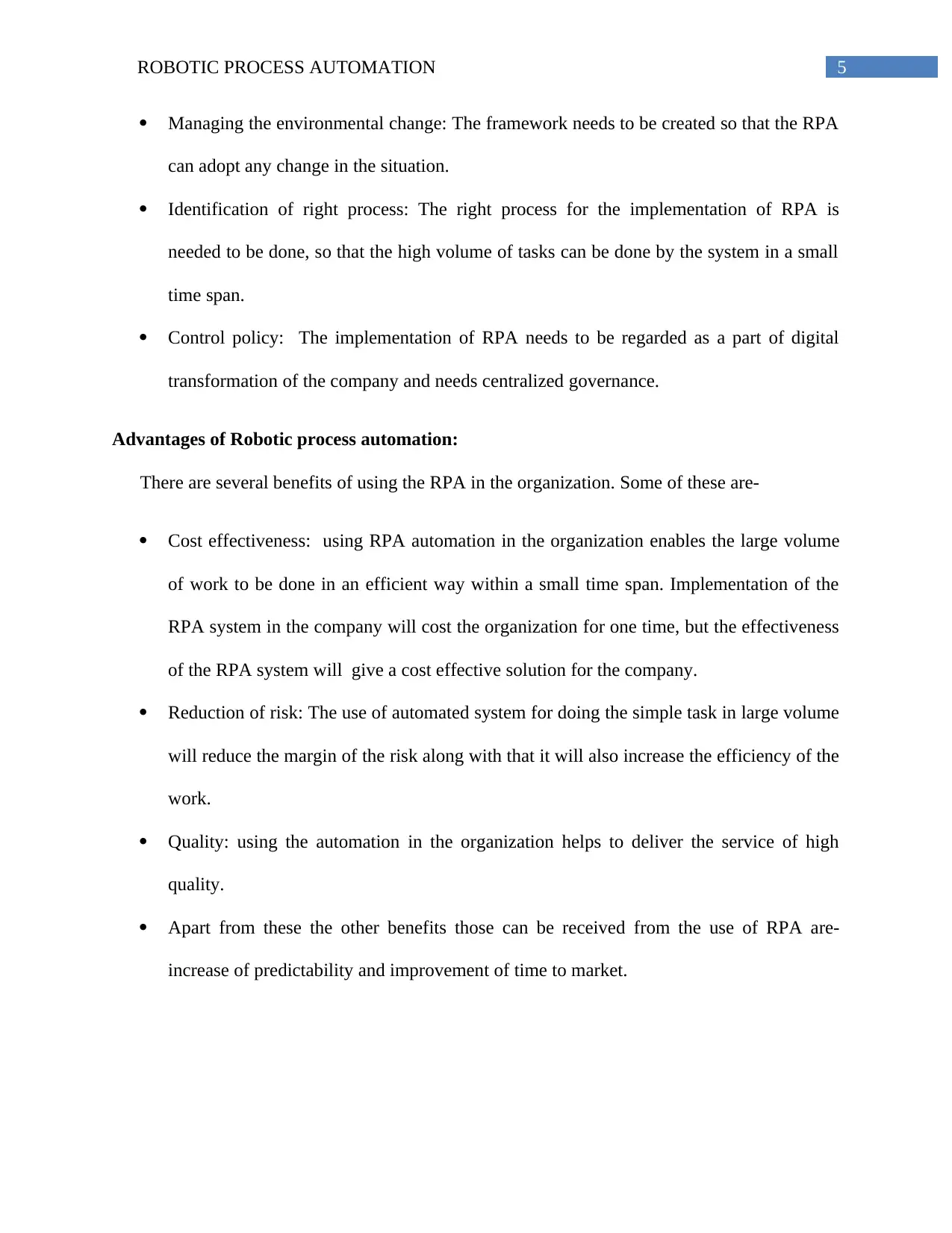
5ROBOTIC PROCESS AUTOMATION
Managing the environmental change: The framework needs to be created so that the RPA
can adopt any change in the situation.
Identification of right process: The right process for the implementation of RPA is
needed to be done, so that the high volume of tasks can be done by the system in a small
time span.
Control policy: The implementation of RPA needs to be regarded as a part of digital
transformation of the company and needs centralized governance.
Advantages of Robotic process automation:
There are several benefits of using the RPA in the organization. Some of these are-
Cost effectiveness: using RPA automation in the organization enables the large volume
of work to be done in an efficient way within a small time span. Implementation of the
RPA system in the company will cost the organization for one time, but the effectiveness
of the RPA system will give a cost effective solution for the company.
Reduction of risk: The use of automated system for doing the simple task in large volume
will reduce the margin of the risk along with that it will also increase the efficiency of the
work.
Quality: using the automation in the organization helps to deliver the service of high
quality.
Apart from these the other benefits those can be received from the use of RPA are-
increase of predictability and improvement of time to market.
Managing the environmental change: The framework needs to be created so that the RPA
can adopt any change in the situation.
Identification of right process: The right process for the implementation of RPA is
needed to be done, so that the high volume of tasks can be done by the system in a small
time span.
Control policy: The implementation of RPA needs to be regarded as a part of digital
transformation of the company and needs centralized governance.
Advantages of Robotic process automation:
There are several benefits of using the RPA in the organization. Some of these are-
Cost effectiveness: using RPA automation in the organization enables the large volume
of work to be done in an efficient way within a small time span. Implementation of the
RPA system in the company will cost the organization for one time, but the effectiveness
of the RPA system will give a cost effective solution for the company.
Reduction of risk: The use of automated system for doing the simple task in large volume
will reduce the margin of the risk along with that it will also increase the efficiency of the
work.
Quality: using the automation in the organization helps to deliver the service of high
quality.
Apart from these the other benefits those can be received from the use of RPA are-
increase of predictability and improvement of time to market.
⊘ This is a preview!⊘
Do you want full access?
Subscribe today to unlock all pages.

Trusted by 1+ million students worldwide

6ROBOTIC PROCESS AUTOMATION
The future of the automation:
The future of the automation may increase the possibility of merging of the RPA and the
artificial intelligence , where, the system can make decision using its own logic and decision
making ability to solve a problem.
Conclusion
It can be concluded from the above discussions regarding the RPA that, the
implementation of this technology is going to be beneficial for the organization. It helps the
organization to work effectively by doing the large volume of tasks in a small time. However, the
enterprise should consider the RPA system as the integrated part of the company. The right
selection of the RPA process is necessary. The right implementation and the maintenance can
make the RPA a valuable digital transformation for the organization.
The future of the automation:
The future of the automation may increase the possibility of merging of the RPA and the
artificial intelligence , where, the system can make decision using its own logic and decision
making ability to solve a problem.
Conclusion
It can be concluded from the above discussions regarding the RPA that, the
implementation of this technology is going to be beneficial for the organization. It helps the
organization to work effectively by doing the large volume of tasks in a small time. However, the
enterprise should consider the RPA system as the integrated part of the company. The right
selection of the RPA process is necessary. The right implementation and the maintenance can
make the RPA a valuable digital transformation for the organization.
Paraphrase This Document
Need a fresh take? Get an instant paraphrase of this document with our AI Paraphraser
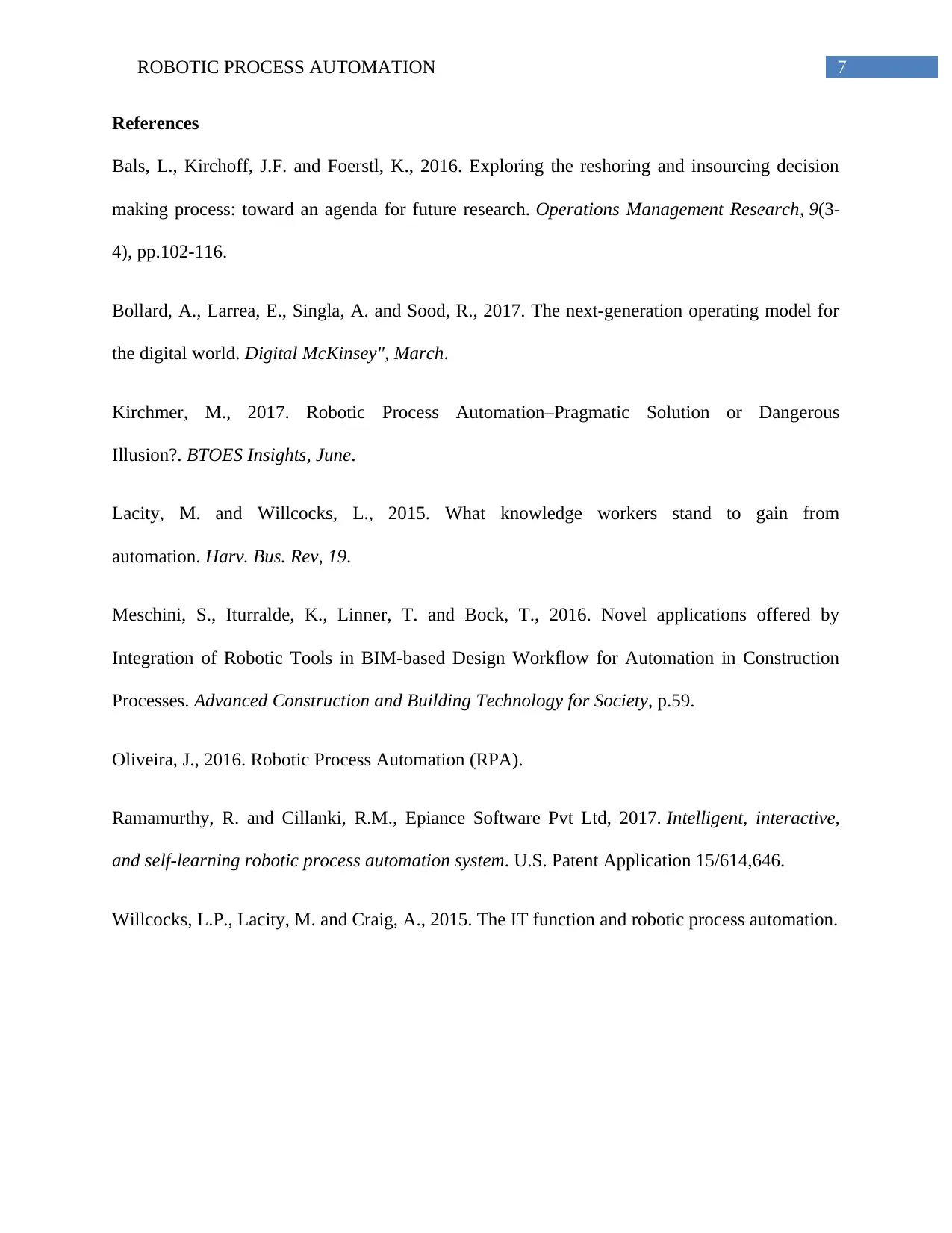
7ROBOTIC PROCESS AUTOMATION
References
Bals, L., Kirchoff, J.F. and Foerstl, K., 2016. Exploring the reshoring and insourcing decision
making process: toward an agenda for future research. Operations Management Research, 9(3-
4), pp.102-116.
Bollard, A., Larrea, E., Singla, A. and Sood, R., 2017. The next-generation operating model for
the digital world. Digital McKinsey", March.
Kirchmer, M., 2017. Robotic Process Automation–Pragmatic Solution or Dangerous
Illusion?. BTOES Insights, June.
Lacity, M. and Willcocks, L., 2015. What knowledge workers stand to gain from
automation. Harv. Bus. Rev, 19.
Meschini, S., Iturralde, K., Linner, T. and Bock, T., 2016. Novel applications offered by
Integration of Robotic Tools in BIM-based Design Workflow for Automation in Construction
Processes. Advanced Construction and Building Technology for Society, p.59.
Oliveira, J., 2016. Robotic Process Automation (RPA).
Ramamurthy, R. and Cillanki, R.M., Epiance Software Pvt Ltd, 2017. Intelligent, interactive,
and self-learning robotic process automation system. U.S. Patent Application 15/614,646.
Willcocks, L.P., Lacity, M. and Craig, A., 2015. The IT function and robotic process automation.
References
Bals, L., Kirchoff, J.F. and Foerstl, K., 2016. Exploring the reshoring and insourcing decision
making process: toward an agenda for future research. Operations Management Research, 9(3-
4), pp.102-116.
Bollard, A., Larrea, E., Singla, A. and Sood, R., 2017. The next-generation operating model for
the digital world. Digital McKinsey", March.
Kirchmer, M., 2017. Robotic Process Automation–Pragmatic Solution or Dangerous
Illusion?. BTOES Insights, June.
Lacity, M. and Willcocks, L., 2015. What knowledge workers stand to gain from
automation. Harv. Bus. Rev, 19.
Meschini, S., Iturralde, K., Linner, T. and Bock, T., 2016. Novel applications offered by
Integration of Robotic Tools in BIM-based Design Workflow for Automation in Construction
Processes. Advanced Construction and Building Technology for Society, p.59.
Oliveira, J., 2016. Robotic Process Automation (RPA).
Ramamurthy, R. and Cillanki, R.M., Epiance Software Pvt Ltd, 2017. Intelligent, interactive,
and self-learning robotic process automation system. U.S. Patent Application 15/614,646.
Willcocks, L.P., Lacity, M. and Craig, A., 2015. The IT function and robotic process automation.
1 out of 8
Related Documents
Your All-in-One AI-Powered Toolkit for Academic Success.
+13062052269
info@desklib.com
Available 24*7 on WhatsApp / Email
![[object Object]](/_next/static/media/star-bottom.7253800d.svg)
Unlock your academic potential
Copyright © 2020–2025 A2Z Services. All Rights Reserved. Developed and managed by ZUCOL.





